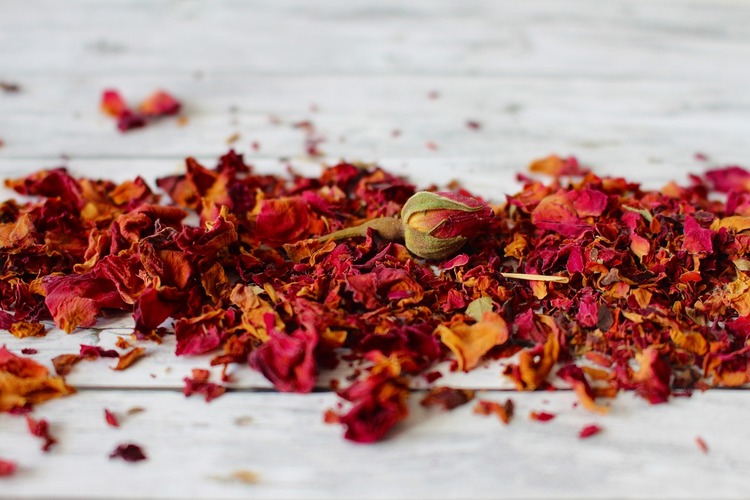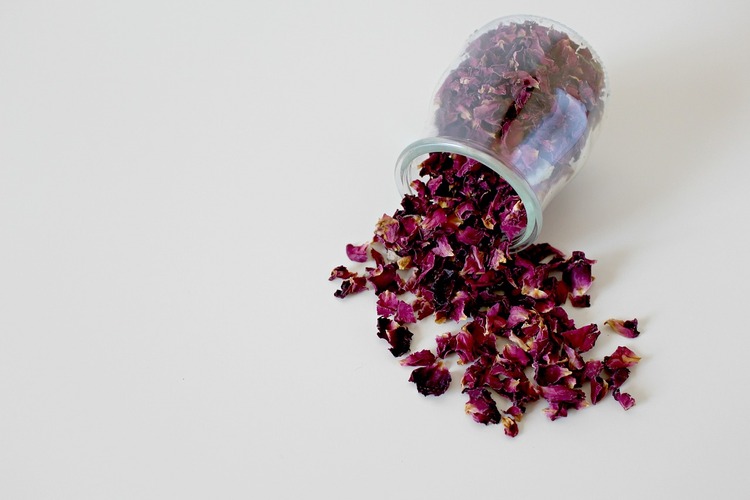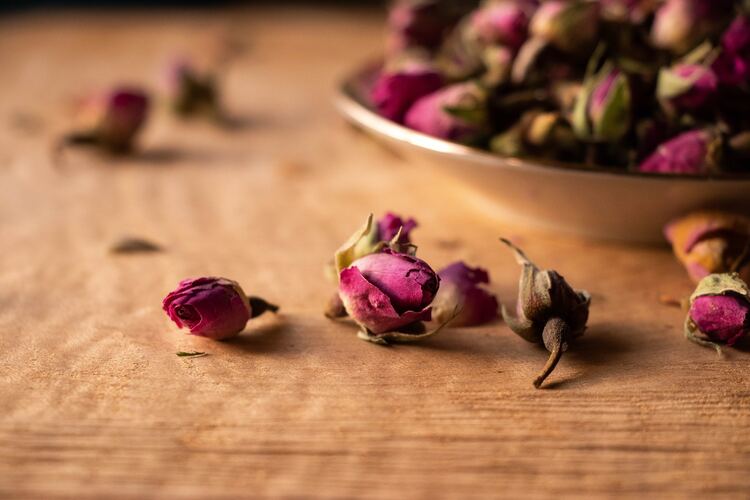Welcome to the delightful world of Rose Oolong Tea! If you’re a fan of oolong tea and the delicate scent of roses, you must keep reading!
This enchanting blend features the robust, earthy flavors of oolong tea with the sweet, fragrant aroma of rose petals. The result is a harmonious and delightful infusion that will make your taste buds sing.
We’re sure you’ll be captivated by the delightful taste and aroma of this blend, making it a fitting addition to your tea collection. Cheers to your new tea adventure!
Please note: This article contains affiliate links, meaning I may earn a commission if you make a purchase by clicking a link. Of course, this comes at no extra cost to you and helps me keep offering readers solid information.

What is Rose Oolong Tea?
Rose oolong tea is a blend of traditional Chinese oolong tea and delicate rose petals. This combination yields floral and earthy notes.
Oolong teas are partially oxidized, which places them between black and green teas in terms of flavor and oxidation. This tea variety is known for its wide range of tastes, from floral and fruity to creamy and buttery. Oolong teas also offer numerous health benefits, such as improving heart health and promoting weight management.
Rose petals are the second key ingredient in this blend. These delicate petals offer a gentle floral aroma and a mild flavor that pairs beautifully with the robust characteristics of oolong tea. In addition to their lovely taste and fragrance, rose petals have some remarkable health properties. They’re known for their calming effects, which can help to alleviate stress and promote relaxation.
When combined, oolong tea and rose petals create a harmonious blend that offers an enchanting flavor.
Origins in Taiwan
Rose oolong tea can trace its roots back to the beautiful island of Taiwan. Known for its exceptional quality of teas, Taiwan has been adhering to traditional tea-making techniques passed down through generations. Rose oolong tea is a unique creation that has emerged from their repertoire.
In Taiwan, the tea leaves are hand-picked, ensuring that only the best leaves are used. After going through the traditional oolong processing methods, the leaves are then skillfully infused with the essence of rose petals. The result is a fragrant and well-balanced tea that bears testimony to the expertise of Taiwanese tea makers.
Tea Characteristics
Taste and Aroma
The flavor profile of rose oolong tea can vary depending on the specific tea blend and the proportions of tea leaves and rose petals. However, here are some general characteristics you can expect:
- Floral: The most prominent flavor in rose oolong tea is the floral note from the rose petals. The taste is often sweet, fragrant, and reminiscent of fresh roses. The floral aroma and taste can be quite pronounced and contribute to the tea’s overall profile.
- Oolong Tea Base: Oolong tea has a unique flavor profile, which can range from light and floral to more robust and earthy, depending on the specific type of oolong used. This oolong base provides a solid foundation for the floral notes of the rose to meld with.
- Sweetness: This tea typically has a naturally sweet and soothing quality, partly due to the floral elements but also influenced by the oolong tea itself. The sweetness can be enhanced with the addition of rose petals or flavoring.
- Aromatic: The aroma of rose oolong tea is one of its most appealing features. The combination of oolong and rose creates a highly aromatic brew with a solid and pleasing scent that can be pretty captivating.
- Subtle Complexity: Some rose oolong teas may have additional layers of complexity, with hints of fruitiness or herbal notes. These nuances depend on the specific oolong base used and the blending process.
Visual Appearance
Examining this tea, you’ll notice its visual appearance beautifully reflects the marriage of flavors. The blend of tea leaves and rose petals creates an aesthetically pleasing combination. The delicate rose blossoms add a pop of color to the darker hues of oolong tea.

Brewing and Steeping
Gong Fu Brewing Method
If you want to enjoy the full flavor of oolong tea, then the Gong Fu brewing method is recommended. This method involves using a small teapot (Yixing clay teapot) and brewing the tea in multiple short infusions. This brewing method ensures the best taste. Here’s how you can do it:
- Preheat your teapot and cups by rinsing them with hot water.
- Add the tea leaves to the teapot. The amount of tea leaves will depend on the size of your teapot, but a general guideline is 1-2 teaspoons of leaves for every 6-8 ounces of water.
- Pour hot water over the tea leaves and immediately pour it out. This helps to rinse the tea leaves and awaken their flavor.
- Refill the teapot with hot water and steep it for about 20-30 seconds.
- Pour the tea into your cups and enjoy the fragrant aroma and delicate taste.
- Repeat steps 4 and 5 for multiple infusions, gradually increasing the steeping time with each infusion. You can increase each infusion’s steeping time by 10 to 20 seconds.
Please pay attention to the last step. You can (and should) infuse your oolong tea multiple times. Please make the most out of it!
Gaiwan Brewing Method
You can use a gaiwan to brew tea as well. A gaiwan is a traditional Chinese tea vessel that allows you to control your tea’s temperature and steeping time. Here’s how to use it:
- Warm the gaiwan and tea cups with hot water,
- Add the tea leaves to the gaiwan. Use 1-2 teaspoons of leaves for every 6-8 ounces of water.
- For heavily roasted oolongs, pour hot water over the tea leaves and immediately pour it out. This helps to rinse the tea leaves and awaken their flavor.
- Slowly pour water over the leaves till the rim of the gaiwan.
- Add the lid and steep for 20-30 seconds.
- Pour the tea into teacups. While doing this, hold the gaiwan with your thumb and middle finger. Secure the lid with the index finger.
- Repeat the process with multiple infusions.
Western Style Brewing
If you prefer to brew tea using Western methods, start by heating the water. Put one teaspoon of tea leaves into a tea infuser or strainer and place it in a cup. Pour the hot water over the leaves and let it steep for about 3-4 minutes. Remove the infuser or strainer, and enjoy your tea.
Ideal Water Temperature
The water temperature plays a crucial role in brewing this tea. If the water is too hot, it can burn the delicate tea leaves and ruin the flavor. On the other hand, if the water is too cold, it may not extract the full flavor of the tea leaves. Here’s the ideal water temperature for brewing this particular tea:
- Bring fresh, cold water to a boil.
- Let it cool down for 2-3 minutes until the water temperature reaches around 190-200°F (88-93°C).
- Pour the hot water over the tea leaves and let it steep for the desired time.
Remember to use fresh, cold water that is free of any impurities. Avoid tap water if possible, as it may contain chlorine or other chemicals that can affect the taste of your tea.
Health Benefits
Heart Health
Rose oolong tea contains antioxidants that can help improve your heart health. These antioxidants can reduce inflammation and cholesterol levels, which in turn helps lower the risk of developing cardiovascular diseases such as heart attacks and strokes. Additionally, the tea can promote better blood circulation, which is vital for maintaining a healthy heart.
Weight Management
Drinking this tea may aid in weight management (in combination with a balanced diet and maintaining regular physical activity). It contains components that can increase fat oxidation and energy expenditure, helping with weight loss. Furthermore, its caffeine content can help boost metabolism, enabling your body to burn calories more efficiently.
Stress Relief
Also, this tea has a soothing effect that can help relieve stress and promote relaxation. The presence of an amino acid called L-theanine in the tea has been known to have calming effects on the mind, making it an ideal choice to unwind after a long day. Additionally, its lovely aroma and flavor can make sipping this tea a comforting experience.

Buying Tips and Reviews
When you’re looking to buy rose oolong tea, it’s essential to keep a few key factors in mind. Start by checking the tea source and ensure it comes from reputable tea gardens. High-quality oolong tea is typically grown in regions such as Fujian and Taiwan.
Reading reviews and considering ratings can provide helpful insights. Look for a product with positive feedback from other customers regarding flavor, aroma, and overall satisfaction. You can find these parameters displayed on websites or online marketplaces where the tea is sold.
In terms of packaging, it’s crucial to choose a tea that is stored in an airtight container or a vacuum-sealed bag to preserve freshness. Some popular brands offer their tea in reusable tins, which can be a bonus for maintaining your tea’s quality.
Another aspect to consider is the blend of the tea. Some rose oolong teas contain pure tea leaves, while others may have rose petals or rosebuds mixed in, so you’ll need to consider your personal preferences. Check the ingredients list for any additional flavorings or additives that may affect the taste and quality of the tea.
To get the best experience out of your tea, you can:
- Compare a few reputable brands to find the one that suits your taste buds the best
- Try samples or smaller-size packages before investing in a larger quantity
- Watch out for sales or discounts that online retailers might offer
If you are looking to purchase online, please consider the following recommendations.
Organic Positively Tea Company, Summer Rose Oolong Tea


When storing your tea, it’s essential to keep it in a cool, dark, and dry place. Airtight containers or sealable bags are your best options for preserving their freshness and flavor. Ensure to avoid direct sunlight and strong odors, as they can affect the quality of your tea.
Comparison with Other Teas
In this section, we’ll compare rose oolong with two popular types of tea: green tea and black tea. We’ll discuss their differences in taste, aroma, and potential health benefits.
Rose Oolong vs Green Tea
Rose oolong is a semi-oxidized tea (we are referring to the tea’s base), while green tea is an unoxidized tea. The oxidation level impacts the flavor and aroma of these teas.
- Taste: Rose oolong tea has a floral and fruity flavor with a mild taste. Green tea, on the other hand, has a more grassy or vegetal flavor.
- Aroma: Rose oolong is often described as sweet and floral, while green tea has a fresh, sometimes slightly bitter scent.
- Health Benefits: Both teas contain antioxidants that can benefit your health. However, while green tea is known for its high content of catechins, rose oolong contains theaflavins and thearubigins.
Rose Oolong vs Black Tea
Now, let’s compare rose oolong tea with black tea. Black tea is a fully oxidized tea, which means it has a higher oxidation level than both oolong and green teas.
- Taste: While rose oolong has a more delicate, floral taste, black tea typically has a robust and bold flavor. The taste of black tea can vary depending on the variety, with some being malty or even slightly smoky.
- Aroma: The aroma of black tea is often stronger than that of rose oolong tea. Black tea can have a rich, full-bodied aroma, sometimes with hints of caramel or chocolate.
- Health Benefits: Black tea also contains antioxidants in the form of theaflavins and thearubigins. These compounds result from the higher oxidation levels, and they may provide different health benefits than those found in green and oolong teas.
Frequently Asked Questions
What are the health benefits of rose oolong tea?
Rose oolong tea combines the benefits of both oolong tea and rose petals. It is rich in antioxidants, which help protect your body from free radicals and reduce the risk of chronic diseases. It may also help with weight management, as it can boost metabolism and aid in digestion. The presence of rose petals adds a soothing effect, potentially reducing stress and promoting a healthy complexion.
How does the flavor of rose oolong tea compare to other teas?
This tea offers an aromatic taste due to the blend of oolong tea and rose petals. The oolong tea provides a distinct, toasty flavor, while the rose petals offer a gentle, floral essence. This combination results in a delicate, well-rounded taste experience that differs from traditional green, black, and herbal teas.
Is there any caffeine content in rose oolong tea?
Yes, there is caffeine in this tea, as oolong tea leaves naturally contain caffeine. However, the caffeine content is typically lower than that found in black tea, making it a suitable choice for those looking to reduce their caffeine intake while still enjoying a flavorful cup of tea.
How to properly brew rose oolong tea?
To brew a perfect cup of this tea, follow these steps:
- Boil the water: A temperature between 190-200°F (88-93°C) works best.
- Measure the tea: Use 1 teaspoon of tea for every 8-ounce cup.
- Steep the tea: Pour the hot water over it and let it steep for 3-5 minutes. You can adjust the steeping time depending on how strong you prefer your tea.
- Strain and enjoy: Finally, remove the tea leaves using a strainer and enjoy your freshly brewed rose oolong tea.
Can I combine rose oolong tea with other flavors?
Absolutely! Rose oolong is versatile and pairs well with many flavors. Feel free to experiment with other herbs, fruits, or sweeteners to create your perfect blend. Some popular choices include adding a hint of lemon, a touch of honey, or blending it with other floral or fruity teas.
What is the best way to store rose oolong tea?
To maintain the freshness and quality of your tea, store it in an airtight container, away from direct sunlight, moisture, and any strong odors. A cool, dark pantry or cupboard is an ideal location. Proper storage will help preserve the delicate flavors and aromas, ensuring a delicious cup of tea every time.

I hope you have enjoyed the article.
Have you tried any of these teas?